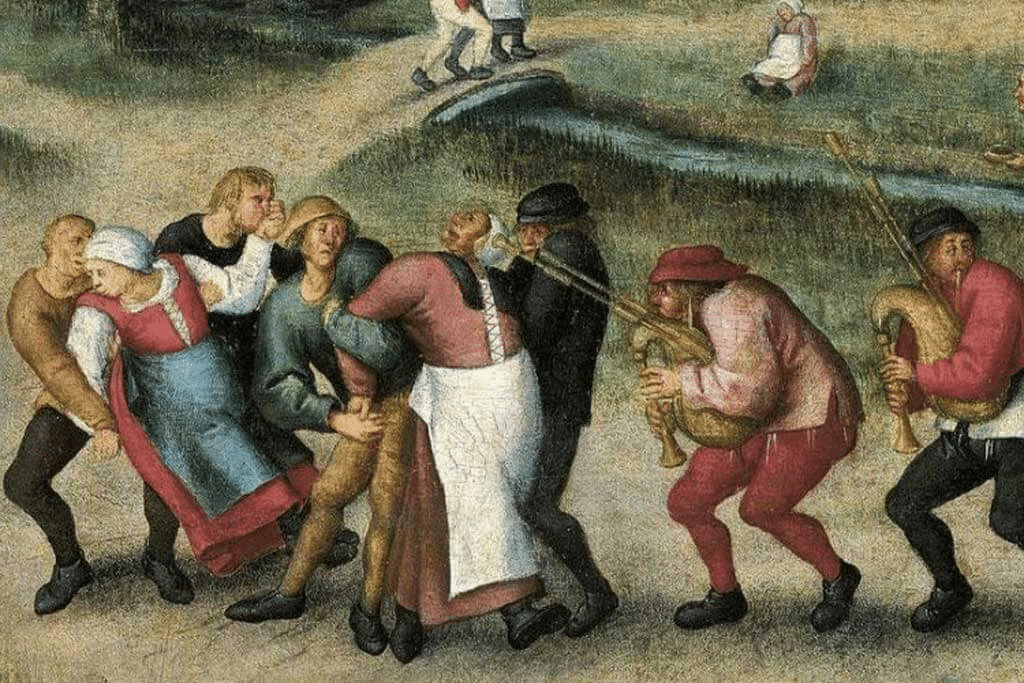You haven’t danced until you’ve danced the Dance of The Dancing Plague.
Yes, you might be adept at all manner of African dances, ranging from Shaku Shaku to Azonto, Alingo, Focus, and even Makosa and that sweeping dance that people do with Agbada at Owambes, but it is just a disguise to sweep money up codedly. Perhaps you’re also one of those people who can dance Alanta without shame…

Or maybe yours isn’t Nigerian-focused. Maybe you’re adept at break dancing, twisting your body into origami-like shapes in the name of rhythm. Whichever it is, I still maintain that you haven’t danced until you’ve danced the Dance of The Dancing Plague.
Because, no matter your skill, you have nothing on people who danced and didn’t stop dancing until they died. Yep, you read that right.
Come with me as we lift up the skirts of history and try to make sense of what the hell happened in 1518.
MORE IN THIS SERIES:
- 25 Famous Artists Everyone Should Know, From Frida Kahlo To Da Vinci
- Snowfall in Africa: Discover The 10 African Countries Where It Snows
- 7 Toxic Behaviors That Are Considered Normal
- Heroine Conquest (Extensive Guide to Ace the Game)
The Dancing Plague of 1518
It was a nice July day in Strasbourg, France. Being a part of the Holy Roman Empire was not as bad as other cities had described it to be. All was well and good.
Until Frau Troffea stepped into the street.

Frau didn’t make any noise, give any introductions, or explain if she’d just signed up to star in Step Up 4 and wanted to brush up on her dance moves. She just started dancing. In the street.
Alas, this wasn’t just a regular dance; it was more of an uncontrollable compulsion, as she couldn’t stop herself from dancing. She was silent, twirling and shaking like her life depended on it. And it wasn’t long before her dance caught the attention of others, and soon a growing number of curious people joined in.
She kept up her solo dance-a-thon for nearly a week, and before long, some three dozen other Strasbourgeois had joined in. And as more and more people joined the dance, it brought with it an unsettling and eerie atmosphere to Strasbourg.
The most puzzling part was that the dancing didn’t stop. Despite exhaustion, injuries, and even death, the dancers showed no signs of stopping. It was recorded that some danced until their feet bled, yet they didn’t stop. Some fainted from exhaustion, but when they came back, they continued at a frenzied tempo, working hard to keep the motion going.

With no other explanation for the phenomenon, local physicians blamed it on “hot blood” and suggested that they simply let the afflicted gyrate the fever away. A stage was constructed and professional dancers were brought in. The town even hired a band to provide backing music, hoping that it would eventually wear the participants out.
Unfortunately, all this was of no avail, as their efforts seemed to intensify the dancing rather than subdue it, and it wasn’t long before the marathon started to take its toll. Many dancers collapsed from sheer exhaustion. Some even died from strokes and heart attacks. The city council tried to ban dancing. They even tried to ban music. All to no avail.
By August, the dancing epidemic had claimed as many as 400 victims. The strange episode didn’t end until September, when the dancers were whisked away to a mountaintop shrine to pray for absolution.
Those who danced were ordered to go to the shrine of Saint Vitus, wore red shoes that were sprinkled with holy water, and had painted crosses on the tops and soles. They also had to hold small crosses in their hands; incense and Latin incantations were part of this “ritual.” In the end, Saint Vitus finally “forgave” them, word spread of a successful ritual, and the Dancing Plague ended.
SEE ALSO: See the Seven Wonders Of the Ancient World
Theories Surrounding The Dancing Plague
According to historian John Waller, the cause of the Dancing Plague most likely concerns St. Vitus, a Catholic saint who pious 16th-century Europeans believed had the power to curse people with a dancing plague. When combined with the horrors of disease and famine, both of which were tearing through Strasbourg in 1518, the St. Vitus superstition may have triggered a stress-induced hysteria called the Dancing Plague that took hold of much of the city.

Other theories have suggested the dancers were members of a religious cult, including:
1. Food poisoning
Some believe that the Dancing Plague could have been caused by food poisoning caused by the toxic and psychoactive chemical products of ergot fungi (ergotism), which grows commonly on grains (such as rye) used for baking bread. Ergotamine is the main psychoactive product of ergot fungi; it is structurally related to the drug lysergic acid diethylamide (LSD-25) and is the substance from which LSD-25 was originally synthesized.
The same fungus has also been implicated in other major historical anomalies, including the Salem witch trials.
However, John Waller, a scholar who had written several journals on the subject matter, argued that “this theory does not seem tenable, since it is unlikely that those poisoned by ergot could have danced for days at a time. Nor would so many people have reacted to its psychotropic chemicals in the same way. The ergotism theory also fails to explain why almost every outbreak occurred somewhere along the Rhine and Moselle rivers, areas linked by water but with quite different climates and crops”.
READ ALSO: New Seven Wonders of the World
2. Stress-induced mass hysteria
The Dancing Plague could also have been an example of fully developed cases of psychogenic movement disorder happening in mass hysteria or mass psychogenic illness, which involves many individuals suddenly exhibiting the same bizarre behaviour. The behaviour spreads rapidly and broadly in an epidemic pattern.
This kind of behaviour could have been caused by elevated levels of psychological stress caused by the ruthless years that the people were going through.
Waller speculates that the dancing was “stress-induced psychosis” on a mass level since the region where the people danced was riddled with starvation and disease and the inhabitants tended to be superstitious. Seven other cases of the dancing plague were reported in the same region during the mediaeval era.
This psychogenic illness could have created chorea (from the Greek khoreia meaning “to dance”), a situation comprising random and intricate unintentional movements that flit from body part to body part. Diverse choreas (St. Vitus’ dance, St. John’s dance, and tarantism) were labelled in the Middle Ages, referring to the independent epidemics of “dancing mania” that happened in central Europe, particularly at the time of the plague.
READ ALSO:
Concluding The Dancing Plague
The exact cause of this Dancing Plague remains uncertain, but over the centuries, similar events are said to have occurred throughout the mediaeval age. In the 11th century, in Kölbigk, Saxony, it was believed to be the result of demonic possession or divine judgement.
Also, in 15th-century Apulia, Italy, a woman was bitten by a tarantula, and the venom made her dance convulsively. The only way to cure the bite was to “shimmy” and to have the right sort of music available, which was an accepted remedy by scholars like Athanasius Kircher.
Despite all of these theories, the Dancing Plague of Strasbourg remains a puzzle yet to be solved. Historical records have also made it challenging to pinpoint the root cause, and the truth remains elusive.
